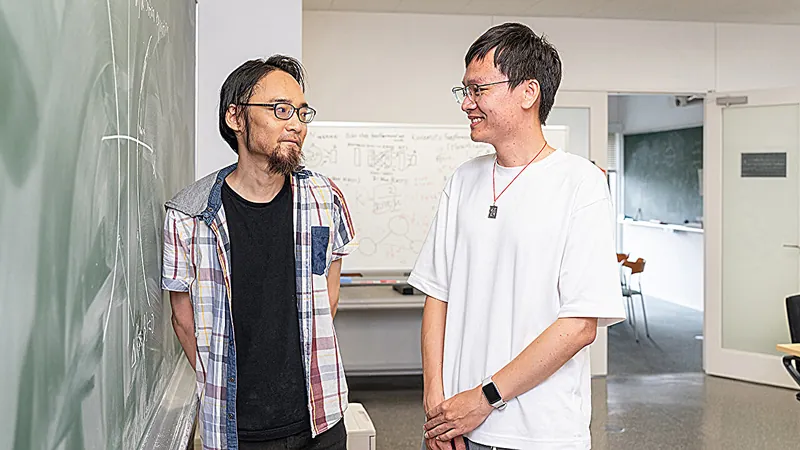
Revolutionary Discovery: New Model Unveils the Secrets of Orbit Changes Near Lagrange Points!
2025-09-22
Author: Ming
Unlocking the Mysteries of Space Travel
The future of advanced space exploration hinges on mastering the complex dynamics of the restricted three-body problem (RTBP). Here, one celestial body—often a spacecraft—is so minuscule that its gravity scarcely influences the other two, typically a planet and its moon. Understanding this delicate balance is crucial for effective trajectory planning.
The Role of Lagrange Points
"In RTBP systems, Lagrange points serve as unique locations where a spacecraft can achieve stable orbits," explains Mingpei Lin, a researcher in the AIMR team. The intricate patterns of orbits, like halo and quasi-halo orbits, that emerge around these unstable collinear points are essential for precise navigation.
Breaking the Numerical Barrier
Despite the significance of Lagrange points, scientists have struggled with a comprehensive analytical method capable of explaining the diverse orbit types. Current numerical simulations can track specific trajectories but are labor-intensive and highly specialized. Fragmented analytical approaches fall short, treating different orbit types in isolation and neglecting critical quasi-halo orbits altogether.
A Game-Changing Analytical Framework
In an exciting breakthrough detailed in a 2024 article in the Journal of Guidance, Control, and Dynamics, Lin and his colleague Chiba have introduced a unified analytical model that elucidates the center manifolds of collinear Lagrange points in RTBP. Their innovative method showcases a coupling mechanism responsible for the bifurcation of quasi-halo orbits from Lissajous orbits—completely sidestepping frequency resonance as the main driver.
"Previous models relied heavily on frequency resonance to explain complex orbit emergence, which inadequately addressed the behavior of quasi-halo orbits," Lin notes. "Our findings suggest that nonlinear coupling—not resonance—is the genuine source of these orbital changes, revealing a dynamic previously overlooked."
A Unifying Solution for Orbit Types
The breakthrough lies in the introduction of a coupling coefficient and a pivotal bifurcation equation. This novel approach ensures that the nonlinear relationships between in-plane and out-of-plane motions lead to a natural emergence of bifurcations, independent of resonance conditions. The resulting high-order series solution provides a cohesive framework for understanding Lissajous, halo, and quasi-halo orbits—all within the same model.
This landmark discovery effectively transforms our grasp of orbital dynamics around Lagrange points, paving the way for refined space mission planning and enriching bifurcation theory.
Expanding the Horizons of Research
Looking ahead, Lin's team aims to extend this coupling-induced framework to diverse dynamical systems, including intriguing topics like the evolution of right-handedness in humans. "This exploratory journey was made possible through my experiences at Chiba Laboratory in AIMR, where I finally had the freedom to delve deeper into this perplexing subject," Lin reflects.
After grappling with conventional methods and facing numerous setbacks, the research team re-evaluated the long-held resonance theory, leading to their groundbreaking insight: that coupling interactions—and not resonance—drive local bifurcations. This revelation not only solved a seven-year riddle for Lin but has also invigorated his passion for venturing into the unknown realms of orbital dynamics.




 Brasil (PT)
Brasil (PT)
 Canada (EN)
Canada (EN)
 Chile (ES)
Chile (ES)
 Česko (CS)
Česko (CS)
 대한민국 (KO)
대한민국 (KO)
 España (ES)
España (ES)
 France (FR)
France (FR)
 Hong Kong (EN)
Hong Kong (EN)
 Italia (IT)
Italia (IT)
 日本 (JA)
日本 (JA)
 Magyarország (HU)
Magyarország (HU)
 Norge (NO)
Norge (NO)
 Polska (PL)
Polska (PL)
 Schweiz (DE)
Schweiz (DE)
 Singapore (EN)
Singapore (EN)
 Sverige (SV)
Sverige (SV)
 Suomi (FI)
Suomi (FI)
 Türkiye (TR)
Türkiye (TR)
 الإمارات العربية المتحدة (AR)
الإمارات العربية المتحدة (AR)